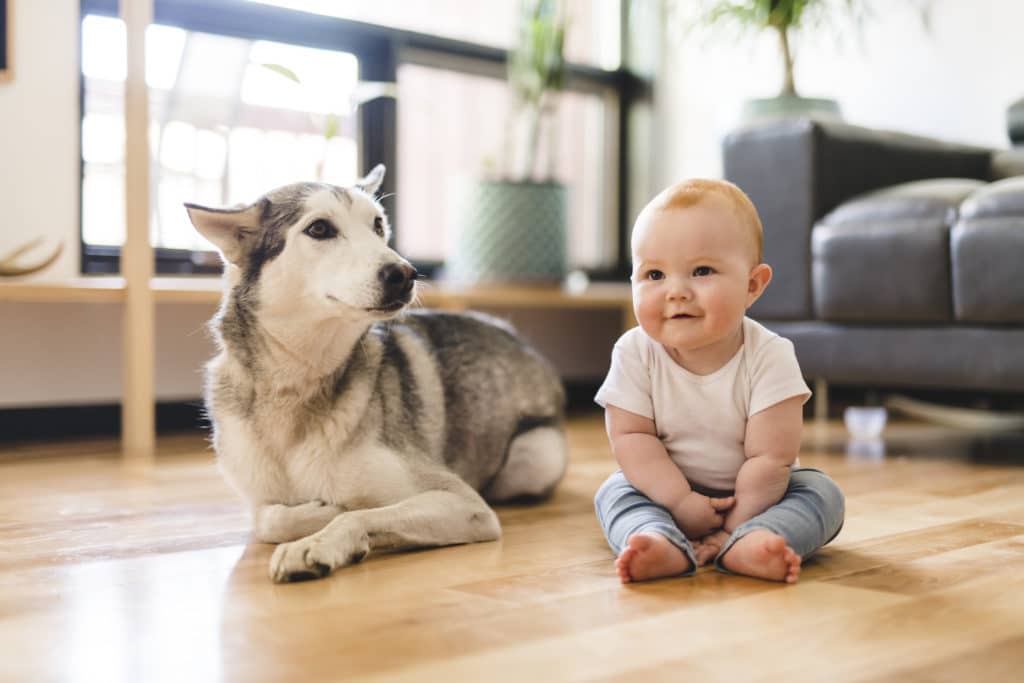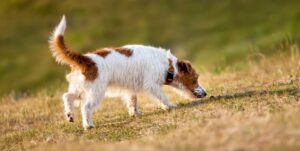You spent the last nine months preparing your dog for this new family member, and the initial meeting went well. But that’s just the beginning!
Your dog’s relationship with your baby will change over time. At each stage of your baby’s development, you’ll encounter new joys and new challenges. The key is to be alert to changes and to monitor interactions between them so you can step in and correct problem behavior — from either your dog or your baby!
Here are a few of the dynamics you may encounter as your baby grows — and how to get through them as a pack.
Stage 1: Newborn and the baby alarm
A newborn brings a whole range of new smells and sounds into your home, and perhaps the most worrying is crying. Remember, your dog picks up on energy, and the energy that your baby is giving off while crying is anything but calm and assertive. Your dog may become distressed, too, whimpering, whining, and barking.
This may be endearing at times (“Aww, look — Spot is worried about you, too!”), but it can also be a problem. A barking dog can get in the way when you’re trying to get a baby to sleep, and often those crying jags happen in the middle of the night, when your neighbors may not appreciate the commotion.
You can help accustom your canine (and human!) family members to the sounds of crying before the new arrival by playing the sound on your computer at loud volumes for extended periods of time. If possible, keep your dog some place where the noises of the baby can’t reach him at night. (That way, at least someone is the house is getting a good night’s sleep!)
One of the most important things you can do during this stage is maintain a regular routine of walks with the whole pack — mom and baby out the door first and at the front of the pack. This not only helps send a message about your baby’s role as a pack leader, but also helps drain your dog’s energy, leading to better behavior overall.
With all the changes of having a new baby, many new parents put dog walks on the back burner, resorting to just letting the dog out in the backyard or a quick stop to the corner. Of course, you may have days where this is simply a necessity, but make that the exception to the rule. Consider dog walks a priority. It’s not just good for your dog; it’s good for you, too.
Stage 2: The sitter and the food thief
 At this stage, your baby is sitting without support, so you’ve likely begun feeding purees and may even be ready to start solid foods. Pretty soon your dog will discover just how rewarding having this new family member around can be. All babies enjoy throwing their food to see what happens, but your baby gets an added benefit: The entertainment of watching your dog beg, jump, and dive for tasty morsels. In fact, your baby may enjoy offering food directly to your dog, making it even harder to discourage this kind of thievery.
At this stage, your baby is sitting without support, so you’ve likely begun feeding purees and may even be ready to start solid foods. Pretty soon your dog will discover just how rewarding having this new family member around can be. All babies enjoy throwing their food to see what happens, but your baby gets an added benefit: The entertainment of watching your dog beg, jump, and dive for tasty morsels. In fact, your baby may enjoy offering food directly to your dog, making it even harder to discourage this kind of thievery.
So what can you do to keep baby’s mealtime under control?
Know your dog. Is he the type to sneak a treat from the kitchen table? Does she get possessive over particularly delectable snacks? Recognizing the issues you may confront before the first feeding can help prepare you for that first meal.
Claim the high chair. Set clear rules, boundaries, and limitations from day one. Bring it out before you’re even considering feeding your baby anything besides breast milk and formula, and let your dog know who owns it. Then take things up a notch by adding some food to the tray.
Get help. It can be hard to keep track of an unruly dog and an unruly baby at the same time. Even if you don’t expect to have any issues with your dog, plan for the first meal to be at a time when there’s someone else at home, so one of you can focus on correcting the dog and one of you can focus on the baby’s needs.
Beware of dangerous human foods. Most of the food that you will be feeding your baby at this stage will be mild on the stomach. In fact, some veterinarians even recommend feeding baby food to a dog with a troubled tummy. But that doesn’t mean that all food you feed to your baby is safe for your dog. For example, avocado is a great treat for a baby — but potentially dangerous for your pup. And any sudden shift in diet can wreak havoc on a dog’s tummy. Keep a list of foods to beware of near the fridge as a reminder, and talk to your veterinarian about any concerns you have.
Put the dog away. If you have any fears about your baby being hurt by an overexcited or possessive pup, make dinner a time when the dog goes away for a while. But be aware that this issue won’t go away over time. Eventually, your baby will grow into a toddler who will want to walk and snack. Consider hiring a professional to work through the issue.
Things only get more exciting as the baby gets moving! Check back to learn about the Crawler and the Test Subject, the Walker and the Bulldozer, and the Toddler and the Playmate in Part 2.
Do your baby and dog get along? Share your experience with us in the comments.











